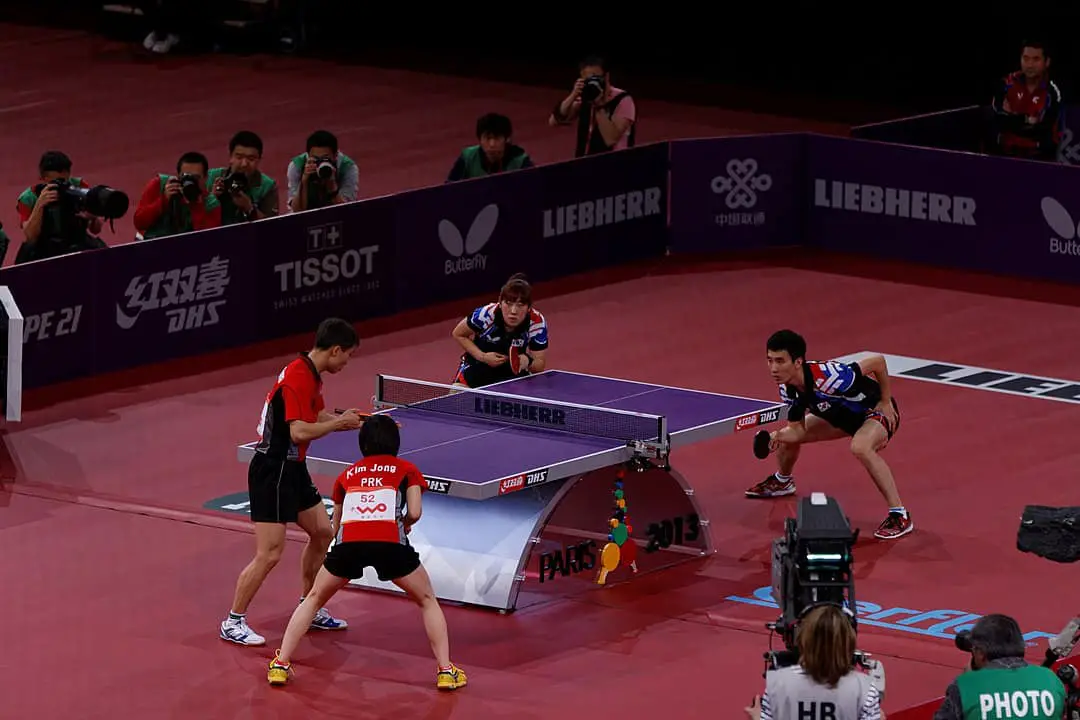If you have already played table tennis and know the singles rules, we reckon it shouldn’t be too difficult for you to understand the table tennis doubles rules. But for those who are looking to drill right into it, here’s our easy to understand guide to table tennis doubles rules for beginners.
Table of Content
Difference between Singles & Doubles Table Tennis
The biggest difference between singles and doubles table tennis (other than the number of players in action obviously!) is the serving.
In singles, the serving player can serve from anywhere on his/her side of the table and to anywhere on the receiver’s side of the table. It’s not so in doubles.
Doubles play in table tennis necessitates the server to serve from the right side of the table and bounce the ball on that right side too, while the second bounce needs to be on the right side of the receiving table.
Serving in table tennis doubles can be indicated by the following, Law 2.6.3.
“As the ball is falling the server shall strike it so that it touches first his or her court and then touches directly the receiver’s court; in doubles, the ball shall touch successively the right half court of server and receiver.”
Also Read:
In order to achieve this distinction between the left and the right side, tables for doubles in table tennis are divided into two half courts as indicated by this law 2.1.6:
“For doubles, each court shall be divided into 2 equal half-courts by a white centre line, 3mm wide, running parallel with the side lines; the centre line shall be regarded as part of each right half-court.”
As mentioned in this law, the line itself will belong to the right half-court which means the service would be called ‘in’ if the ball’s hit the line on the opponent’s side of the table.
Order of Play in Doubles in Table Tennis
After the service changes, the originally receiving player from the other team becomes the server while the original server exchanges places with his teammate, who now becomes the receiver.
Unlike most other racket sports, table tennis follows a different rule for the order of play in which doubles is played. The same player from a team cannot play successive shots in doubles in table tennis.
What this means is, let’s assume players A and B are in Team 1 and players C and D are in Team 2. If A is serving and C is receiving, it means the third shot in this order of play has to be played by B, which has to be followed by D and this A-C-B-D cycle repeats itself till the point finishes.
The point is lost by the team which breaks this sequence.
This necessitates all four players featuring in a rally need to be a part of the point and in equal measure.
The aforementioned rule doesn’t apply to wheelchair table tennis.
When a table tennis match has at least one wheelchair user playing, once the server has made the serve and the designated receiver has returned it, the rest of the point can be played by any of the players without going through the aforementioned order of play.
If either of the two players of a match which has at least one player in a wheelchair crosses the imaginary center line of the table, then the point is won by the opponent.
Serving and Receiving Order in Doubles Table Tennis
According to Law 2.13.4:
In each game of a doubles match, the pair having the right to serve first shall choose which of them will do so and in the first game of a match the receiving pair shall decide which of them will receive first; in subsequent games of the match, the first server having been chosen, the first receiver shall be the player who served to him or her in the preceding game.
What this implies is, lots will be drawn to decide which doubles team serves first in the opening game.
Based on this the team serving first will decide which one of the two players will serve first. The receiving team will then get the chance to opt which player will receive first.
In the next game, the team which was receiving will now start off with the serving and decide on which of the two players will serve. The receiver in this game will be the player who had served to this player in the opening game.
So if A & B are playing C & D, and in the first game, A had begun serving to C, and if in the second game, the team decides D will start serve, it implies automatically B will be the receiver.
Sequence of Serving and Receiving in a Game
According to Law 2.13.5:
In doubles, at each change of service the previous receiver shall become the server and the partner of the previous server shall become the receiver.
As simple as it gets. Taking the sample example as above, let’s assume A & B are playing C & D.
Also Read:
If in the first game, A is serving to C, the service will change after two points and C will now become the server but the receiver will now be B. After two points, B will become the server and D the receiver and this will be followed by D serving to A.
This sequence will continue till the end of the game.
Serving in the Final Game of a Table Tennis Doubles Match
According to Law 2.13.6 & 2.13.7:
The player or pair serving first in a game shall receive first in the next game of the match and in the last possible game of a doubles match the pair due to receive next shall change their order of receiving when first one pair scores 5 points.
The player or pair starting at one end in a game shall start at the other end in the next game of the match and in the last possible game of a match the players or pairs shall change ends when first one player or pair scores 5 points.
These two laws specifically deal with the final game of the match.
Continuing with the aforementioned example. If A is serving to C to begin things off in the final game and if the A/B pair gets to five points, the two teams will switch sides of the table and A will now serve to D for the rest of the game and the rest of the changes of serves will happen accordingly.
What Happens in Case of Errors in Serving/Receiving Order or Changing Ends?
As soon as the error is discovered, the correct order will need to re-established based on who should have been serving and receiving at that stage but there will be no change in the score. Similarly, the correct ends will re-established and the score will stand.
Final Words on Table Tennis Doubles Rules
While most racket sports have differences in the rules for singles and doubles, table tennis is unique in the sense that it also has a pre-decided order in which the players can come into play during a doubles rally. That, among others, is the most important table tennis doubles rule one needs to keep in mind before getting down to business.


